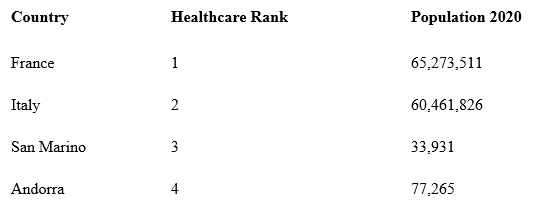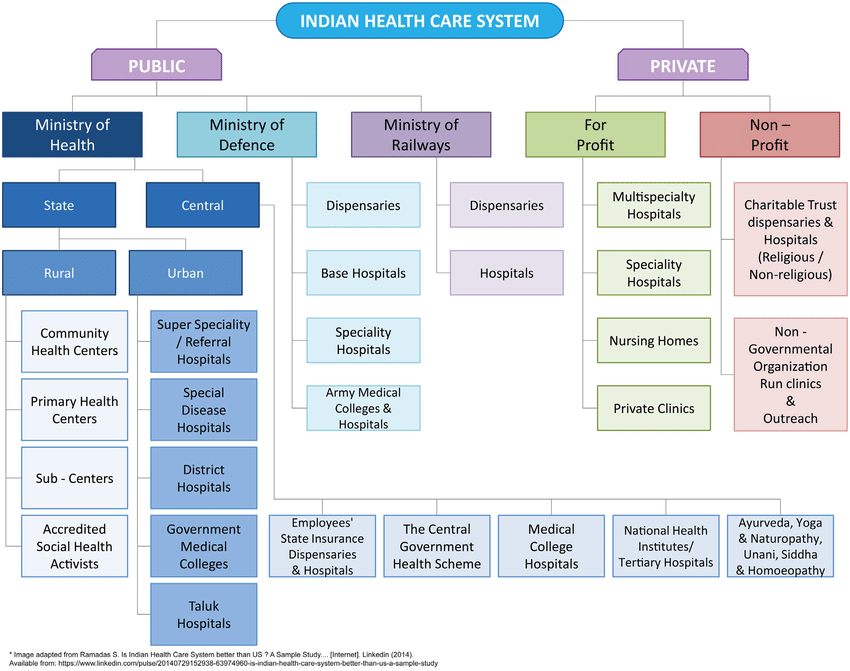Root cause analysis of healthcare system in India | Importance of primary level healthcare facility

The Healthcare system is a single entity with a character of dispersion. It runs on different principles in different nations. The Indian healthcare system is built on three tiers. The primary, secondary and tertiary care facilities. Due to lack of adequate financial support, the primary facilities are going through a severe setback. This article focuses on this aspect of the healthcare scenario in India.
“Healthcare facility is a necessity. Healthcare domains is a business”
- Anonymous
Introduction
In the Figure 1. the names of the nations with the best healthcare system in the world. Ironically, Italy is the first nation to have been engulfed by the pandemic situation. It has led to complete inflation followed by the depression of Italy. Experts around the world have blamed the inefficiency of the healthcare systems of the fallen economy of the nations.
The best healthcare system in the world?
Related Articles

Fig . The top three nations with the best healthcare facility. (Source: Google, Apr 30, 2020)
India is the fifth-largest economy in the world whereas Canada holds the position of the third-largest economy. Cuba is running behind in terms of Gross Domestic product value (GDP). The scenario is different in terms of ranking these nations in case of healthcare systems. The United States is the world’s largest economy. They also have the most expensive healthcare system in the world. On the contrary, they are not responsible for a sustainable healthcare system.
There is a symbiotic relationship between an effective healthcare system and the economy of a nation. Healthcare systems are responsible for maintaining the health of the labour and manpower of a nation. The inefficiency can result in declined availability of manpower, ultimately affecting in running the economy of a nation. This article will focus on the healthcare systems in the following nations (pre covid-19 attack).

Fig . Relationship between an efficient healthcare system and its effect on the economy of a nation.
Effect of pandemic situation in 2020 in healthcare systems
United States are not having the best (effective) healthcare system in the world, as per recent reports. The recent pandemic situation has provided a ground reality when the entire United States economy collapsed within a few months due to a lack of an effective healthcare system. India, on the other hand, has shown greater sustenance in terms of postponing economic inflation through its healthcare system. This could happen because India has been operating from the primary level healthcare facilities. This pandemic situation has forced the Government of India to understand the importance of primary level healthcare facilities.
Root cause analysis of the gap in Indian healthcare system
The reason for a mundane healthcare system in India is ineffectiveness in the primary level healthcare system. India has a population where the majority lies in the urban and rural areas. The return on investment in those areas has always been occupying a lower figure as compared to investments made in tier cities. As a result of which, private interventions were never felt in those regions. The government had been the provider for healthcare services in terms of:
• Primary level healthcare facilities.
• ASHA workers.
• National health programs.
These methods of implementation had always suffered due to lack of capital injection. It has to be noted that the government had been allowing adequate funds to be implemented in these areas. Those funds never reached the right amount in the right places. The public healthcare hierarchy has always been an obstruction in the implementation and development of primary level healthcare facilities.

Fig. Hierarchy of healthcare funding
The private healthcare facilities are immune to such modes of transactions. The monopoly in private organisations works in the favour of providing of quality healthcare services and products. In India, Government of India checks the private organisation in the form of:
• Auditing of balance sheets and income statements.
• Quality assurance protocols and guidelines.
• Service feedback under fixed protocols and surveillance.
The private organisations has been dominating the Indian healthcare market. The pharmaceutical industries have their monopoly (lack of government involvement). The revenues earned from the private sectors are feasible and adequate. In recent years, it has been noted that a majority of the Indian citizens fail to avail the premium healthcare facilities. This was the reason for implementation of ‘Public Private Partnership’ (PPE).

Fig. Root cause analysis for the gap in Indian healthcare system
Through the above diagram the importance of primary care hospitals are essential. This is the solution for the root cause of a mundane healthcare sector in India in terms of Public Health.
Healthcare system in India | Public and Private healthcare system.

Fig. Branching of healthcare system in India (Source: Research Gate)
Healthcare system in India is divided into two parts. Public and private healthcare facilities. Some of the common aspects of both sectors are:
Tertiary care hospitals.
Medical institutions for research and studies.
Clinics and laboratories.
In the case of Government facilities, the charges induced are feasible for the lower-income group. It has resulted in a movement of the upper and middle-income group towards private healthcare facilities. The revenues earned are always inclined towards the private sectors. India should take inspirations from the healthcare structures of Cuba and Canada (discussed below).

Fig 6. Healthcare demography In India (Source: wharton.upenn.edu)
The healthcare system of India is divided into two categories:
• The Public Healthcare system.
• The Private Healthcare system.
The Public healthcare system follows the hierarchy of primary, secondary, and tertiary systems. The entire system is headed by the Ministry of Health and Family Welfare (MoHFW) committee. It is presided over by the directorate general of health and the health minister of the country. The public healthcare system follows the policy of providing healthcare facilities to those who are below the poverty line. India is a country where 70 percent of the population relies on pharmaceutical products. The public health system is poorly funded. A primary reason is, India is a country where less than 4percent of the population pay the government taxes. This is a surprising estimate. As a result of which, the hospitals in the different levels of hierarchy are devoid of the following:
• proper quality measures
• medical devices and equipment
• Manpower (doctor to patient ratio is less)
• Sanitation
• Medical beds
As a result of which, the middle and higher-income groups opt for the Private healthcare system. This is the reason, India is devoid of an efficient healthcare system because of this gap.
Fig 7. India spends the least in healthcare among developing nation (Source: DownToEarth)
Public-Private Partnership | Rise to Government healthcare segregation

(Source: The Wire)
Through this venture, the Indian Government is planning a coordinated approach that will universally lead to an effective healthcare system. The private sector consists of 58 percent of the hospitals, 29 percent of the beds, and 81 percent of the doctors. Due to lower income in the public sectors, the doctors tend to move towards private healthcare institutions. Some of the doctors decided to run their private healthcare facility. This has resulted in acute segregation of the healthcare system in India. Through PPP, the Government is trying to form a link between the hospitals of both the sectors.
PPP has been implemented back in 2002. A tertiary care government hospital was symbiotically added with Apollo Hospitals. The feedback analysis after 10 years, did not seem promising in 2012. In 2020, privatisation of healthcare services in India has began. Government is trying to build an effective primary healthcare system. The private investors are directed to invest in the primary healthcare facilities. The recent initiative by ‘Melinda Gates foundation’ in the states of Uttar Pradesh in India is an example of PPP initiatives.
Drawback of PPP
Investment and involvement of private healthcare organisations can improve the flow of several processes. This can also increase the cost of production of goods and services. Every private organisation believes in return on investment. This will result in added financial burden of people in the lower income level. The feasible ways for availing those services is yet a topic of discussion. This can also result in increased prices of goods and services. The extreme result will be an a growth rate in mortality rate in lower and middle income group.
Conclusion
A strong healthcare system can only form by the effective implementation of strategy and capital injection with ethical supervision. Presently, India is moving towards digital healthcare with the advent of Telemedicine, digital health records, digital information facilities. The recent pandemic situation has taught us the importance of an effective healthcare system.
References
[1] canada.ca
[2] who.int
[4] google.com
[5] thelancet.com
[6] canada.ca
[7] wikipedia.org
Similar Blogs

By Ritika Zalke
Firstly we prepare the platform for designing, then test with users, implementation, and integration with the sales-warehouse system. In most cases, the work to generate sales is still ahead of us. Ap...

By Rohit Tumane
Facebook quietly rolled out its new Analytics tool in May. Most brands don’t even know it exists yet! It’s a powerful platform (with a mobile app version) that rivals Google Analytics and helps ad...
.jpg)
By Kirti Choudhary
With a continuous change in customer's tastes, preferences, and requirements businesses that can change according to the dynamic environment and come up with new methods and techniques can surviv...
Sign up for email alerts
Stay current with our latest insights